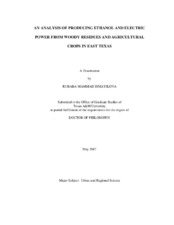| dc.contributor.advisor | Rogers, George O. | |
| dc.creator | Ismayilova, Rubaba Mammad | |
| dc.date.accessioned | 2007-09-17T19:32:14Z | |
| dc.date.available | 2007-09-17T19:32:14Z | |
| dc.date.created | 2003-05 | |
| dc.date.issued | 2007-09-17 | |
| dc.identifier.uri | https://hdl.handle.net/1969.1/5773 | |
| dc.description.abstract | The increasing U.S. dependence on imported oil; the contribution of fossil fuels to the
greenhouse gas emissions and the climate change issue; the current level of energy
prices and other environmental concerns have increased world interest in renewable
energy sources. Biomass is a large, diverse, readily exploitable resource. This
dissertation examines the biomass potential in Eastern Texas by examining a 44 county
region. This examination considers the potential establishment of a 100-megawatt (MW)
power plant and a 20 million gallon per year (MMGY) ethanol plant using
lignocellulosic biomass. The biomass sources considered are switchgrass, sugarcane
bagasse, and logging residues. In the case of electricity generation, co-firing scenarios
are also investigated. The research analyzes the key indicators involved with economic
costs and benefits, environmental and social impacts. The bioenergy production
possibilities considered here were biofeedstock supported electric power and cellulosic
ethanol production. The results were integrated into a comprehensive set of information
that addresses the effects of biomass energy development in the region. The analysis indicates that none of the counties in East Texas have sufficient
biomass to individually sustain either a 100% biomass fired power plant or the cellulosic
ethanol plant. Such plants would only be feasible at the regional level. Co-firing
biomass with coal, however, does provide a most attractive alternative for the study
region. The results indicate further that basing the decision solely on economics of
feedstock availability and costs would suggest that bioenergy, as a renewable energy, is
not a viable energy alternative. Accounting for some environmental and social benefits
accruing to the region from bioenergy production together with the feedstock economics,
however, suggests that government subsidies, up to the amount of accruing benefits,
could make the bioenergies an attractive business opportunity for local farmers and
investors. | en |
| dc.format.extent | 1078505 bytes | en |
| dc.format.medium | electronic | en |
| dc.format.mimetype | application/pdf | |
| dc.language.iso | en_US | |
| dc.publisher | Texas A&M University | |
| dc.subject | biomass | en |
| dc.subject | bioenergy | en |
| dc.title | An analysis of producing ethanol and electric power from woody residues and agricultural crops in East Texas | en |
| dc.type | Book | en |
| dc.type | Thesis | en |
| thesis.degree.department | Landscape Architecture and Urban Planning | en |
| thesis.degree.discipline | Urban and Regional Science | en |
| thesis.degree.grantor | Texas A&M University | en |
| thesis.degree.name | Doctor of Philosophy | en |
| thesis.degree.level | Doctoral | en |
| dc.contributor.committeeMember | Brody, Samuel D. | |
| dc.contributor.committeeMember | El-Halwagi, Mahmoud | |
| dc.contributor.committeeMember | McCarl, Bruce A. | |
| dc.type.genre | Electronic Dissertation | en |
| dc.type.material | text | en |
| dc.format.digitalOrigin | born digital | en |


